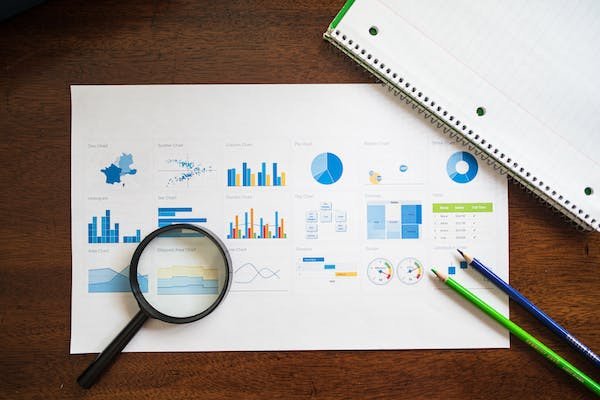Data visualization web design is a lot of things. It’s a way to deliver the truth through data, and it’s also a way to get people to read your content. It’s not just about charts and graphs, though; it’s about using those to make your point and keep readers engaged with your content.
Data visualization and web design can complement each other if you do it right. When the two are brought together, interesting and compelling user interfaces can be created for data visualizations. We’ve been working on data visualization web design for years, and now we’re going to share our best practices for data visualization web design with you!
What Is Data Visualization?

Data visualization is a way of presenting information in a way that helps people understand it better. It’s a way of making complex information more accessible and easier to process so that people can make decisions based on the data instead of just what they’ve heard.
Data visualization can take many forms, from simple graphs to interactive maps and infographics. And with so many different types of data available now, there are also plenty of ways to visualize it. The best way to understand how data visualization works are to see it in action.
Data visualization is used for many purposes, including:
- Presenting information to other people.
- Solving problems by exploring data interactively.
- Plotting large datasets and finding patterns in them.
Read More: Below the Fold Web Design
Why Do We Need Data Visualization?
Why do we need data visualization? Because we’re living in an age where there’s more information than ever before. There are so many different sources giving us so much information, and it’s all coming at us at once. The internet has created a world where we’re constantly bombarded with new ideas, new facts, and new knowledge.
But how do you get all this information? And how do you make sense of it? Data visualization helps us organize the massive amounts of information coming at us every day into digestible chunks that both our eyes and our brains can easily digest. Data visualization allows us to take in new information without being overwhelmed by it and without forgetting what we’ve learned.
How Can Data Visualization Be Created?

Data visualizations can be created using many different tools, including Tableau, D3 (or d3), Processing, and Highcharts. Some tools allow for more flexibility; however, all tools have their advantages and disadvantages depending on what type of data you’re working with (i.e., relational or non-relational).
When creating data visualization, there are many things to consider:
- What type of information do you want to convey?
- Who will be using your product? (Are they experts or novices?)
- What kind of interface do they expect?
Why Data Visualization Is Important?
Data visualization is a graphical representation of information. Data visualization design is an essential part of any business, and it can be used to present a wide range of data, from product sales to customer demographics.
We wrote down 5 points that show why Data Visualization is important:
- Evokes a Strong Emotional Response
- Visualization Accelerates Understanding
- Make More Memorable Moments
- Helps Users Make Sense of Large Amounts of Information
- Allows Users to Process Visual Information Efficiently
1) Evokes a Strong Emotional Response
There are many different types of data visualization, from simple charts to complex diagrams, that can evoke a strong emotional response. The most common type of data visualization is the chart or graph, which presents numerical data in an easy-to-read format. This type of visualization allows you to quickly see trends and patterns in your data without having to read through pages of numbers or text.
Other types of data visualization include maps and diagrams, which can help readers understand large amounts of information quickly by organizing it into categories like geographical locations or periods.
2) Visualization Accelerates Understanding

Data visualization helps us understand data by presenting it in a visual form that is simple and easy to comprehend. The human brain processes visuals 60,000 times faster than text alone. When you present information in a data visualization graphic design format, it’s easier for people to understand than if you just presented them with raw numbers or text.
This is why we’ve seen so many new tools emerge recently, such as Tableau, which allows users to create interactive dashboards from their data without coding knowledge.
3) Make More Memorable Moments
Data Visualization is important because it allows people to make more memorable moments.
When a website visitor comes to your page, what do you want them to remember? You want them to remember where they can find the information they need and how easy it is to get there. You also want them to remember the layout of your site so that if they come back later (or tell someone else about it), they’ll be able to navigate around easily.
When people look at graphs or charts, they can see the data in a way that makes sense and allows them to understand what is going on. This helps them make decisions about the future and how they should handle certain situations. It also helps them see patterns they might not have noticed before and therefore make better choices in the future.
Read More: How To Get A UX Design Job With No Industry Experience
4) Helps Users Make Sense of Large Amounts of Information

The most obvious reason data visualization is important is that it helps users make sense of large amounts of information. Humans are visual creatures, so we’re much better at comprehending things when they’re presented visually. For example, if you were asked to read through a spreadsheet containing all of your company’s sales figures over a given period, chances are you’d be able to remember most or all of the information once you finished reading it. But if someone asked you how many sales there were on each day during that same period? That is not so likely.
5) Allows Users to Process Visual Information Efficiently
Another reason why data visualization is important is that it allows us to use our brain’s natural ability to process visual information more efficiently than text-based information. While this may seem like common sense, studies have shown that people retain more information when they’re presented with charts and graphs instead of lists or tables.
Data Visualization in Digital Products
Data visualization can be used to collect and display data, as well as to analyze it. For example, a business could use data visualization to show the number of customers by location over time, or they could use it to show the number of customers who bought a product at each price point.

There are many different types of data visualizations, but they all fall into one of two categories: chart types and statistical methods. Statistical methods include correlation analysis and regression analysis; these methods don’t rely on visual representations (like charts); they provide information about how two variables relate. Charts are visual representations that show relationships between variables; there are many kinds of charts: pie charts, bar graphs, line graphs, etc.
Let us walk you through ways you can use data visualization in digital products.
1) The Use of Visualization to Support Core Concepts

Data visualization is used to support core concepts in digital products. It is a means of conveying information in a way that makes it easier to understand and is, therefore, extremely useful when dealing with complex concepts.
When creating a data visualization, one should consider what the goal of the visualization is and how it will be used by users. For example, if you are designing an interactive dashboard that requires user input or interaction, then you should make sure that it is clear how users interact with this dashboard.
Read More: What is a UX Design Challenge and Its Examples
2) Visualization That Conveys a Narrative
It’s no secret that the human brain is wired to respond to visuals; we’ve been using images to illustrate our ideas since long before the invention of written language. When you combine this fact with the way that computers process data, it’s easy to see why visualizations have become such an important part of digital design. But what does it mean to “design an effective data visualization”?
A good data visualization should be easy to understand and easy to use. The information conveyed by a well-designed graphic should be clear, concise, and intuitive. It should also be able to tell a story in its own right. It should have a beginning, middle, and end, just like any other piece of content.
When designing data visualizations for digital products, keep these three principles in mind: clarity, conciseness, and narrative!
Best Practices for Data Visualization Web Design

Data visualization, or the art of turning complex data into something easy to understand, is one of the most important parts of web design. The better you can express your data, the more effective your website will be.
Here are some best practices for data visualization web design:
- Identify the Message You Wish to Convey
- Deliver the Truth
- Display the Appropriate Amount of Data
- Identify Your Audience
- Determine What Your Goals Are
- Decide on a Visual Approach
- Understand Your Data
- Use Aesthetically Pleasing Charts
- Charts Should Be Easy for People With Disabilities
- Use Color Wisely
- Consider the Proportionality of Your Charts
- Keep Things Simple
Read More: 17 Web Design Mistakes You Should Try to Avoid
1) Identify the Message You Wish to Convey
First, identify the message you wish to convey. What is the point of this visualization? What do you want viewers to take away from it? Once you’ve figured that out, you’ll be able to decide what type of information will be most helpful in conveying that message and how best to present it.
Next, look at other designs that have been successful with similar messages and focus on what makes them work well. This will help you avoid making unnecessary mistakes or avoiding common pitfalls. Finally, consider how the design will work across different devices and browsers so that everyone who sees the project has access to all its features and information at once.
2) Deliver the Truth
Data visualization is a great way to deliver the truth engagingly, but it’s not always easy to get right. Use clear, concise language that explains what each chart means and what question it answers without being overly technical. A good data visualization web design should deliver the truth. If your graphics are too busy or confusing, they will be unreadable, and nobody will understand them.
A bad data visualization web design should not try to be clever but instead focus on communicating the truth. Make sure that all of your graphics are high quality so that they can be easily read by people with any level of vision impairment (people with color blindness, people who are visually impaired, etc.).
3) Display the Appropriate Amount of Data

When it comes to data visualization web design, choosing the appropriate amount of data to display is key. You want to make sure that the viewer can see and understand the information you’re presenting them with, not so much that it’s overwhelming and too difficult for them to parse, but not so little that they leave feeling like they didn’t get what they came for.
You should always keep in mind that the purpose of your website is to provide this information in a way that makes sense for your audience. If you’re trying to convey something specific, then it’s up to you as the designer to ensure that this information is clear and easy to read.
4) Identify Your Audience
As you’re designing a data visualization, an important thing you need to do is identify who your audience will be. This is essential because it will help you determine what information and visuals they need to see and how you present them.
For example, if you’re creating an infographic for a business owner or manager, you’ll want to focus on the results of your analysis rather than the raw data itself. But if you’re creating an interactive visualization for students or other researchers, it’s more important that they have access to all the raw data so they can dive into it themselves.
Read More: How to Build a Winning Startup Product Design Team
5) Determine What Your Goals Are
Before you dive into the design process, it’s important to determine what your goals are. Are you designing a website for an organization? A product launch? A single blog post? These factors will affect the design process and how you should approach your data visualization web design.
When designing for an organization, it’s important to consider the brand guidelines of that organization. This can help you avoid making design choices that could damage the credibility of your client’s brand. It’s also important to consider whether or not the site is meant to be used as a landing page or if it will be used as part of a larger site. If it’s meant to be used as part of a larger site, what sort of experience does that larger site offer?
6) Decide on a Visual Approach

Another step in data visualization web design is choosing the right visual approach. There are many ways to visualize your data, so it’s important to think about what you want to communicate and which method will best accomplish that goal.
For example, if you’re trying to show the changes in sales over time, an area chart might be your best bet. If you’re looking to show how many people used each product at a given time, a pie chart might be the better choice.
7) Understand Your Data
You need to know what information your users are looking for and how they’ll use it. You should also think about how much time they’re willing to spend on a page. If they’re doing research, they might want to explore a lot of different visuals to find what they’re looking for. But if they’re trying to find an address or phone number, they probably don’t want anything more than simple text links.
8) Use Aesthetically Pleasing Charts

You should consider using charts that are aesthetically pleasing and simple enough that they don’t distract from the main point of your content. You want your user’s eyes to go straight to the points you want them to see without having them get distracted by other elements on the page.
9) Charts Should Be Easy for People With Disabilities
Make sure that all of your charts are easy for people with disabilities, especially people who use screen readers to access them. This means making sure all of your charts have alt text set up properly so that if someone can’t see what’s going on in a specific chart, there will be something there telling them what it shows (and why).
You should also make sure that all of your charts are responsive so they’ll work on mobile devices as well as desktops/laptops; this ensures that regardless of where someone is viewing your site from, they’ll still get an experience worthy of their time and attention.
10) Use Color Wisely
Color can be a powerful tool in data visualization, but it can also be distracting if you don’t use it right. You want to choose colors that will stand out to the eye while still being cohesive with the rest of the design.
Don’t just throw random colors on a page; use them in a way that helps convey meaning. For example, if you have numbers that increase as time goes on (like temperature readings), use warmer colors like reds and oranges at first and then switch over to cooler ones like blues and greens when things start getting colder again later on down the line (think about the color scheme used by weather forecasters).
11) Consider the Proportionality of Your Charts

Make sure the size of your charts is proportional to their importance. If you’re showing sales figures for three different regions over five years, for example, make sure that each column has more than enough room for all of its information without overlapping or crowding other columns out of view (which would defeat the purpose of using a chart in the first place).
12) Keep Things Simple
If there’s too much going on in one chart or graph, then people may get confused about what they’re supposed to be focusing on, and if they have trouble finding what they’re looking for, then they’ll give up on reading further and go back home instead which is increasingly likely as time goes by.
Read More: Difference Between Web Design and Web Development
Websites With Data Visualization Driving User Experience

Data visualization is a powerful tool for any business, but it’s also a powerful tool for the user. Data visualization can help users understand and interpret data in a way that makes it easier to interact with and understand. This is especially true when it comes to websites with data visualization driving user experience.
When you’re working on your website or your client’s website, you want to make sure that your site design works for both you and them, and this means making sure that the user experience is optimized. Data visualization websites that drive user experience are designed to help users easily interpret data in ways that are meaningful to them.
When designing a website with data visualizations, there are several things you’ll want to consider:
- How will this site be used?
- What kind of data do they need?
- What kind of layout makes sense?
- How much information should each page contain?
- How will the user interact with this site?
When developing a new website or redesigning an existing one, these questions should be in your mind. The more time you spend thinking about these questions before starting work on the site, the more likely your final product will be one that users find easy to use and helpful in getting their jobs done quickly.
Read More: Tips For Choosing A Web Design Company
Bottom Line
Data visualization is not just a hot topic in web design, it is growing in popularity. That being said, the data visualization community still faces challenges. That’s why it’s important to make sure you pick the right tools for your data visualization project. When working on data visualization, clarity and simplicity should be two of your main concerns.
In the end, data visualization is an excellent method of conveying a wealth of information in a visually appealing way. It’s an excellent tool whether you’re trying to convey complex information or enhance an existing design with additional visual appeal. And when it comes to web design, data visualization can be an excellent way to make your site more interactive and compelling for users. It’s definitely worth trying out, so if you haven’t already started working with data visualization in your projects, stop putting it off, get out there, and have fun!
FAQs
What Is Web-Based Data Visualization?
Utilizing graphic elements like charts, maps, or layouts to describe data is a technique known as data visualization. It converts quantitative, complicated, or high-volume data into an understandable visualization. Tools for data visualization enhance and simplify the method of visual storytelling for details and precision.
Are UX Designers Required to Study Data Visualization?
A depiction approach called data visualization includes reorganizing statistics to produce insightful information. To better communicate complicated concepts and reasoning, it makes use of graphs, charts, graphics, and other formats. To better portray data in its designs, UX designers need to get comfortable with visualization.
